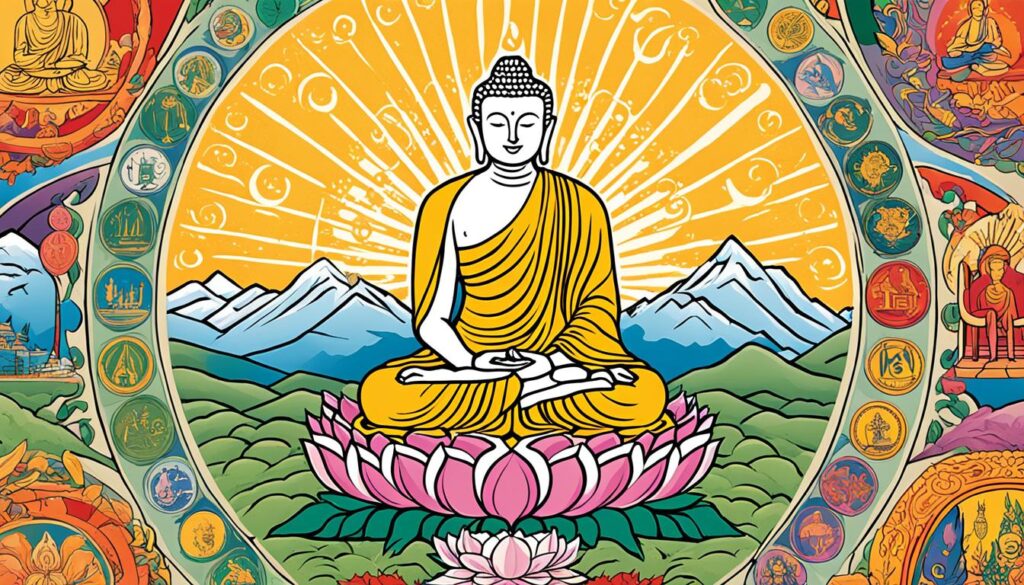“Do not dwell in the past, do not dream of the future, concentrate the mind on the present moment.” – Buddha
Welcome to a journey of self-discovery and enlightenment through the major beliefs of Buddhism. Buddhism, one of the world’s oldest religions, offers profound teachings and principles that can transform your perspective on life. Rooted in the wisdom of Siddhartha Gautama, the Buddha, these beliefs provide guidance on finding inner peace, understanding suffering, and achieving enlightenment.
At its core, Buddhism challenges us to look beyond the mundane and find purpose and fulfillment in our lives. It invites us to let go of attachments, embrace impermanence, and cultivate mindfulness. Through this exploration of Buddhist philosophy and teachings, you can unlock the potential for personal growth, inner harmony, and profound spiritual insight.
Key Takeaways:
- Discover the Three Universal Truths and Four Noble Truths that form the core beliefs of Buddhism.
- Understand the importance of meditation and mindfulness in achieving inner peace and enlightenment.
- Explore the teachings of the Buddha and the practical application of the Five Precepts in daily life.
- Learn about the different schools of Buddhism and their unique practices and traditions.
- Gain insights into Tibetan Buddhism and the role of the Dalai Lama in preserving its spiritual heritage.
The Three Universal Truths and Four Noble Truths
In Buddhism, there are fundamental beliefs that provide insight into the nature of existence and offer guidance for leading a meaningful life. The Three Universal Truths and Four Noble Truths form the core principles of Buddhist philosophy.
The Three Universal Truths
- Impermanence: Everything in life is impermanent and subject to change. This truth reminds us to embrace the transient nature of existence and not cling to temporary things or relationships.
- Suffering: Human life involves suffering. From physical pain to emotional anguish, suffering is an inevitable part of our existence. Recognizing this truth allows us to acknowledge and address our own suffering and empathize with the suffering of others.
- No Eternal Soul: There is no eternal, unchanging soul. Buddhism teaches that the concept of a permanent self or soul is an illusion. Instead, our identities and experiences are shaped by ever-changing conditions and circumstances.
The Four Noble Truths
- The Truth of Suffering: Life is characterized by suffering, which includes physical pain, mental anguish, and dissatisfaction. This truth encourages us to confront the reality of suffering and recognize its pervasive nature.
- The Cause of Suffering: The cause of suffering is identified as greed, desire, and attachment. Clinging to material possessions, relationships, and expectations creates a cycle of craving and dissatisfaction.
- The End of Suffering: The Four Noble Truths offer hope by asserting that there is a way to end suffering. By eliminating craving and attachment, one can achieve liberation from suffering and find lasting peace.
- The Middle Path: The path to ending suffering is known as the Middle Path. It is a balanced approach that avoids extremes, neither indulging in sensual pleasures nor practicing extreme self-denial. The Middle Path encompasses right understanding, values, speech, action, work, effort, mindfulness, and meditation.
Understanding and embracing these truths can lead to personal transformation and a deeper understanding of the nature of existence. By walking the Middle Path, individuals can cultivate compassion, wisdom, and ultimately attain enlightenment.
| Universal Truths | Noble Truths |
|---|---|
| Impermanence | Truth of Suffering |
| Suffering | Cause of Suffering |
| No Eternal Soul | End of Suffering |
The Importance of Meditation in Buddhism
Meditation is an essential practice in Buddhism, allowing individuals to cultivate mindfulness, seek enlightenment, and experience nirvana. Through focused mental concentration, meditation helps attain inner stillness and tranquility, guiding practitioners on their spiritual journey toward awakening.
Buddhists employ various forms of meditation to deepen their understanding and achieve higher states of consciousness. Some sit quietly and observe their thoughts and sensations, while others engage in dynamic practices like martial arts or walking meditation.
Contemplation of riddles or poems, chanting mantras, and focusing on the breath are also integral to Buddhist meditation. These techniques serve as anchors, grounding the mind in the present moment and fostering a deep sense of awareness.
By turning inward and exploring their own minds, Buddhists can connect with their true nature and recognize the impermanence of all things. This process of self-discovery leads to a profound insight into the nature of reality and the interconnectedness of all beings.

Mindfulness and Enlightenment
Meditation cultivates mindfulness in practitioners, enabling them to live consciously and fully in the present moment. By observing thoughts, emotions, and sensations without judgment or attachment, one gains insight into the transient nature of existence and the fundamental causes of suffering.
Through sustained practice, the state of mindfulness expands, permeating all aspects of life. This heightened awareness brings clarity, compassion, and wisdom, allowing practitioners to engage with the world in a more wholesome and authentic manner.
Seeking Nirvana
Nirvana, the ultimate goal of Buddhist practice, represents liberation from the cycle of birth, death, and rebirth. It is a state of complete freedom from suffering and attachment, characterized by profound peace, joy, and understanding.
Meditation serves as a powerful tool on the path to nirvana, as it helps clear the mind of distractions, attachments, and unwholesome habits. By transcending ordinary consciousness, practitioners can experience a deep sense of presence and aliveness that goes beyond words.
The journey to nirvana through meditation is deeply personal and transformative. Each practitioner must navigate their own inner landscape, confronting and transcending their own fears, desires, and illusions.
| Meditation Benefits | Practices |
|---|---|
| Enhanced concentration and focus | Concentration meditation, focused attention on breathing |
| Stress reduction and emotional well-being | Loving-kindness meditation, mindfulness meditation |
| Increased self-awareness and introspection | Vipassana meditation, insight meditation |
| Cultivation of compassion and empathy | Tonglen meditation, metta meditation |
Meditation in Buddhism is not simply a relaxation technique; it is a profound spiritual practice that awakens the potential for enlightenment within each individual. By regularly engaging in meditation, Buddhists can deepen their understanding of the self, develop compassion for all beings, and progress along the path to enlightenment.
The Teachings of the Buddha
After attaining enlightenment, the Buddha dedicated the rest of his life to imparting his wisdom to others. His teachings, known as the teachings of the Buddha, were meticulously recorded and compiled in the Tripitaka – a collection of sayings, thoughts, and rules for Buddhist monks.
The Buddha’s teachings encouraged individuals to take responsibility for their own lives and actions, emphasizing personal accountability rather than worshiping him as a god. One of the fundamental teachings is encapsulated in the Five Precepts, which provide guidelines for leading a moral and compassionate life:
- Not harming or killing living things: This precept reinforces the importance of respecting all forms of life and promoting non-violence.
- Not taking what is not freely given: Practicing generosity and refraining from stealing or taking what is not intended for us.
- Leading a moral life: Upholding ethical conduct by avoiding harmful actions and cultivating virtues such as honesty, integrity, and kindness.
- Speaking kindly: Using words that are truthful, beneficial, and compassionate, while refraining from speech that may harm oneself or others.
- Avoiding drugs and alcohol: Abstaining from substances that cloud the mind and hinder clear thinking, mindfulness, and understanding.

These teachings provide a moral compass and serve as a foundation for ethical behavior and personal growth in Buddhism. By adhering to these principles, individuals can cultivate compassion, mindfulness, and wisdom, ultimately leading to inner peace and spiritual development.
The Different Schools of Buddhism
Buddhism encompasses various schools or branches, each with its own distinct practices and traditions, while sharing the core beliefs and principles of the religion. The three major schools of Buddhism are Mahayana, Theravada, and Vajrayana.
Mahayana Buddhism
Mahayana Buddhism is prevalent in countries like China, Japan, and Korea. This school emphasizes the importance of bodhisattvas, enlightened beings who delay their own enlightenment to assist others in their spiritual journeys. Mahayana Buddhists view bodhisattvas as role models and seek to cultivate compassion and altruism in order to benefit all sentient beings.
Theravada Buddhism
Theravada Buddhism is commonly practiced in Southeast Asian countries such as Thailand, Myanmar, Sri Lanka, and Cambodia. This school emphasizes monasticism and meditation as key practices for attaining enlightenment. Theravada Buddhists strive to follow the teachings of the historical Buddha, Siddhartha Gautama, and to achieve liberation from the cycle of birth and death.
Vajrayana Buddhism
Vajrayana Buddhism is primarily practiced in regions such as Tibet, Nepal, Bhutan, and Mongolia. Also known as Tantric Buddhism, Vajrayana offers a faster path to enlightenment through the use of advanced meditation techniques and rituals. This school places great emphasis on the guidance of spiritual teachers, known as lamas, and incorporates esoteric practices to attain spiritual liberation.
While each school of Buddhism has its unique approach and rituals, they all share the common goal of seeking liberation from suffering and achieving enlightenment.
| School | Key Features | Main Regions |
|---|---|---|
| Mahayana | Emphasis on bodhisattvas, compassion, and altruism | China, Japan, Korea |
| Theravada | Focus on monasticism and meditation | Thailand, Myanmar, Sri Lanka, Cambodia |
| Vajrayana | Advanced meditation techniques and esoteric practices | Tibet, Nepal, Bhutan, Mongolia |

The table above provides a summary of the key features and main regions associated with each school of Buddhism.
The Dalai Lama and Tibetan Buddhism
The Dalai Lama is a revered figure in Tibetan Buddhism, serving as the spiritual leader and traditionally the head of Tibet. His role holds great importance in the hearts and minds of Tibetan Buddhists, who regard him as the embodiment of compassion and wisdom. The current Dalai Lama, believed to be the 14th reincarnation, is Tenzin Gyatso, who assumed the position at the tender age of five in 1940.
However, the Dalai Lama’s journey has not been without challenges. In 1959, he fled from Chinese-controlled Tibet to seek refuge in India, following widespread opposition to Chinese rule. Throughout the years, the Dalai Lama has been an advocate for peace, non-violence, and the preservation of Tibetan culture and Buddhist values.
Reincarnation plays a central role in Tibetan Buddhism and the lineage of the Dalai Lama. According to Tibetan belief, when the current Dalai Lama passes away, his soul is reincarnated into a new body. The search for his reincarnation involves a process guided by spiritual and historical methods to identify the child who is believed to embody the Dalai Lama’s spirit.

Tibetan Buddhism Practices and Rituals
Tibetan Buddhism incorporates elements of Mahayana Buddhism, including the veneration of bodhisattvas – individuals who have achieved enlightenment but continue to work for the liberation of all beings. This emphasis on compassion and the benefit of all sentient beings distinguishes Tibetan Buddhism from other schools of Buddhism.
Tibetan Buddhist practices often involve intricate rituals, chanting, and the use of various visual aids, such as mandalas and prayer wheels. These practices aim to cultivate mindfulness, amplify positive intentions, and deepen spiritual understanding. Monastic life is also widely followed in Tibetan Buddhism, with monks and nuns dedicating their lives to study, meditation, and serving the community.
| Key Aspects of Tibetan Buddhism | Practices and Rituals |
|---|---|
| Reincarnation of the Dalai Lama | The search for the next Dalai Lama involves a series of arduous procedures combining spiritual guidance and historical traditions. |
| Veneration of Bodhisattvas | Tibetan Buddhists offer prayers, make offerings, and seek the guidance and blessings of bodhisattvas in their quest for enlightenment. |
| Monastic Life | Monks and nuns devote themselves to a disciplined life of study, meditation, and service to others, following the teachings of Tibetan Buddhism. |
| Prayer Wheels | Prayer wheels contain mantras written on rolls of paper or engraved on metal cylinders. Spinning the wheel is believed to send blessings and prayers into the world. |
Conclusion
Buddhism offers profound insights and teachings for personal and societal harmony. Its major beliefs, including the Four Noble Truths and the Middle Path, provide guidance for understanding suffering, overcoming desire, and achieving enlightenment. By acknowledging the impermanence of life and the causes of suffering, Buddhists are able to embark on a transformative journey towards liberation and inner peace.
Meditation plays a central role in Buddhism, allowing individuals to cultivate mindfulness and achieve a state of deep introspection. Through the practice of meditation, one can develop a heightened awareness of their thoughts, emotions, and sensations, ultimately leading to a sense of calmness and clarity. This state of mindfulness allows for greater compassion towards oneself and others, fostering a more harmonious and compassionate society.
With different schools and traditions, Buddhism has spread across the world, inspiring millions of people to seek truth, wisdom, and understanding. Whether it is the Mahayana tradition in East Asia, the Theravada tradition in Southeast Asia, or the Vajrayana tradition in Tibet and the Himalayan region, the fundamental principles and teachings of Buddhism remain universal.
Overall, Buddhism offers a comprehensive guide for navigating the complexities of life, transcending suffering, and attaining enlightenment. It provides individuals with a practical philosophy that can be adapted to their own unique circumstances, enabling them to lead fulfilling, purposeful lives. As you explore the teachings of Buddhism, may they bring you clarity, compassion, and a deeper understanding of yourself and the world around you.
FAQ
What are the major beliefs in Buddhism?
The major beliefs in Buddhism include the Three Universal Truths and the Four Noble Truths. Buddhism also emphasizes mindfulness, compassion, and meditation for achieving inner peace and enlightenment.
What are the Three Universal Truths and Four Noble Truths in Buddhism?
The Three Universal Truths state that everything in life is impermanent and always changing, a life based on possessions does not bring true happiness, and there is no eternal, unchanging soul. The Four Noble Truths teach that human life involves suffering, the cause of suffering is greed, there is a way to end suffering, and the way to end suffering is to follow the Middle Path.
Why is meditation important in Buddhism?
Meditation is important in Buddhism because it allows individuals to cultivate mindfulness, find inner peace, and seek enlightenment. It involves focusing the mind to achieve stillness and a deep sense of presence.
What are the teachings of the Buddha?
The Buddha’s teachings are recorded in the Tripitaka, a collection of sayings, thoughts, and rules for Buddhist monks. The Buddha taught people to take responsibility for their own lives and actions. The Five Precepts are guidelines for daily life in Buddhism, which include not harming or killing, not taking what is not freely given, leading a moral life, speaking kindly, and avoiding drugs and alcohol.
What are the different schools of Buddhism?
Buddhism has different schools or branches, including Mahayana, Theravada, and Vajrayana. Mahayana Buddhism emphasizes the role models of bodhisattvas and is prevalent in countries like China, Japan, and Korea. Theravada Buddhism is common in Southeast Asian countries and emphasizes monasticism and meditation. Vajrayana Buddhism is practiced in Tibet, Nepal, Bhutan, and Mongolia, and offers a faster path to enlightenment.
Who is the Dalai Lama and what is Tibetan Buddhism?
The Dalai Lama is the spiritual leader of Tibetan Buddhism and traditionally the head of Tibet. Tibetan Buddhism incorporates aspects of Mahayana Buddhism and developed unique practices and rituals. The current Dalai Lama, believed to be the 14th reincarnation, fled from China-controlled Tibet to India in 1959. Tibetan Buddhists actively resist Chinese control, and the Dalai Lama has raised questions about his future reincarnation.
What is the significance of Buddhism’s major beliefs?
Buddhism’s major beliefs, such as the Four Noble Truths and the Middle Path, provide guidance for understanding suffering, overcoming desire, and achieving enlightenment. These teachings offer profound insights and teachings for personal and societal harmony, inspiring millions of people to seek truth and live compassionate lives.

